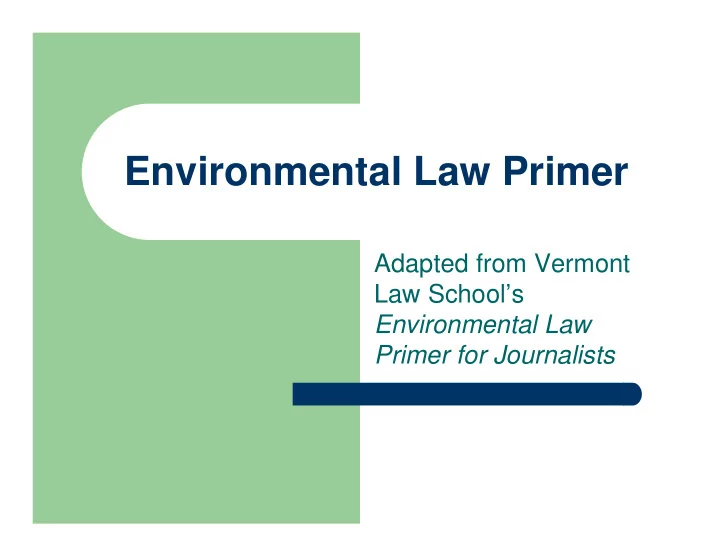

Environmental Law Primer Adapted from Vermont Law School’s Environmental Law Primer for Journalists
General Categories � Command and Control � Liability � Disclosure � Ecosystem and Place-based Programs � Marketable Permits, Offsets, and Cap & Trade � Environmental Assessment and Planning � Cross-Compliance � Preservation � Wildlife � Conservation
Command and Control � Top-down, technology- � Require monitoring and based standards self- reporting; designed to reduce � Enforcement provisions pollutants at the source; with substantial penalties; � Ambient, health-based � Citizen suits; standards designed to protect humans and the � Provisions allowing states environment from and tribes to administer or exposure; supplant federal � Permits that set programs. pollution limits for individual point Examples : Clean Air Act, Clean sources; Water Act, Safe Drinking Water Act
Liability for Contamination and Damage � These laws impose liability on parties responsible for spills and releases. � Characteristics: – Strict liability – Retroactive liability – Joint and several liability – Transferable liability – Liability for damages to natural resources � Example : Comprehensive Environmental Response Compensation and Liability Act
Disclosure � These laws require regulated entities to publicly report releases and spills of hazardous materials and toxic substances. � Examples : – Section 311 of the Clean Water Act – Oil Pollution Act of 1990 – Emergency Planning and Community Right-to- Know Act (Toxics Release Inventory) of 1986
Ecosystem and Place-Based Programs � These laws take a comprehensive ecological approach to regulating land and water uses within large ecosystems. � Examples : – Coastal Zone Management Act of 1972 – Clean Water Act of 1987 (Establishing “place- based” programs in the Great Lakes, Chesapeake Bay, Long Island Sound, and Lake Champlain)
Marketable Permits, Offsets, and Cap & Trade Programs � Set limits on the amount of pollution that can be introduced into the air and water, and then allow trading in pollution credits to achieve reductions. � Generally embedded within “command and control” regulatory programs. � Examples: – Acid Rain Control Program under the Clean Air Act – Water Pollution Trading Program under § 402 of CWA – Wetland Mitigation Bank program under § 404 of CWA – Habitat Conservation Planning program under § 10 of ESA
Environmental Assessment and Planning � These laws require federal agencies to engage in environmental assessments and public participation processes. � Examples: – National Environmental Policy Act of 1969 – National Historic Preservation Act of 1966
Cross-Compliance � These laws use the “power of the purse.” – Condition federal assistance to encourage conservation practices on private land. � Examples: – Coastal Barrier Resources Act � Prohibits federal flood insurance or disaster relief for development on designated barrier islands and beaches. – Food Security Act of 1985 (Swampbuster and Sodbuster) � Prohibits farm subsidies for crops grown on designated wetland and erodible soils.
Preservation � These laws seek to preserve important natural, historical, and cultural resources by prohibiting development and activities that would damage, harm, or degrade them. � Examples: – Antiquities Act of 1906 – National Park Service Act of 1916 – Wilderness Act of 1964 – National Marine Sanctuaries Act of 1972
Wildlife � These laws seek to protect and manage fish and wildlife and their habitat. � Characteristics: – Restrictions on fishing, hunting, trapping, harassment, and other direct forms of “take”; – Restrictions on activities that cause indirect harm to species through habitat destruction and degradation; – Cooperative agreements with states; – Citizen suits or judicially enforceable claims; – Special consultation and other planning requirements; – Mitigation requirements.
Wildlife Examples: � Migratory Bird Treaty Act of 1916 � Marine Mammal Protection Act of 1972 � Endangered Species Act of 1973 � Magnuson-Stevens Fishery Management and Conservation Act of 1996
Conservation � These laws seek to manage public lands and waters for “multiple uses” including mining, forestry, grazing, recreation, water supply, and fish and wildlife habitat. � Characteristics: – An “Organic Act” setting the management goals and policies for the relevant federal land system; – A classification system for permitted and unpermitted uses; – Long term (e.g. ten year) management plans; – Public participation and appeals; – Environmental assessments and consideration of alternatives; – Monitoring of performance standards for commodity outputs and amenity values.
Conservation Examples: Multiple Use Sustained Use Yield Act of 1960 � National Wildlife Refuge Administration Act of 1966 � National Forest Management Act of 1974 (NFMA) � Federal Land Policy and Management Act of 1976 �
Recommend
More recommend